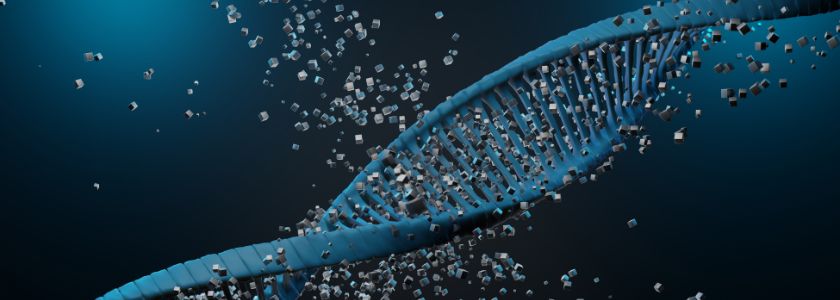Transcription and translation: 5 differences to know about

The Takeaway: You could be forgiven for confusing the terms “transcription” and “translation.” Not only do they sound similar, but their functions have a degree of similarity to them. Throw replication into the mix and there is even more opportunity for confusion. Despite the similarities, these functions are distinct and worthy of deeper investigation.
All of the cells in a multicellular organism contain the exact same DNA. Despite that, cells containing the same DNA can have profound physiological differences. This occurs because of differential gene expression, a term that refers to the combination of genes that are expressed or repressed in particular cells, making that cell unique.
All of the cells in a multicellular organism contain the exact same DNA. Despite that, cells containing the same DNA can have profound physiological differences. This occurs because of differential gene expression, a term that refers to the combination of genes that are expressed or repressed in particular cells, making that cell unique.
What is transcription?
Transcription is the synthesis of RNA from a DNA template. The code in the DNA is converted to a complementary code of RNA.
What is translation?
Translation is the synthesis of a protein from an RNA template. The code of mRNA is converted into a protein’s amino acid sequence.
What is replication?
Replication is what happens when a cell divides and its two strands of DNA split into two single strands, each of which acts as a template for a new strand of complementary DNA.
5 differences between transcription and translation
- The purpose of transcription is to make RNA copies of genes. The purpose of translation is to synthesize proteins for cellular functions.
- Translation produces proteins, while transcription produces mRNA, tRNA, rRNA, and non-coding RNA.
- In prokaryotes, translation and transcription occurs in the cytoplasm. While in eukaryotes, translation happens on the ribosomes and transcription occurs in the nucleus.
- Transcription begins when an RNA polymerase protein binds to a promoter in DNA and creates a transcription initiation complex. Translation begins when a ribosome, initiation factor, and tRNA bind mRNA near a starting codon.
- The molecules (RNA) that result from transcription contributes to what is know as the cell's transcriptome, while translation generates proteins which contribute to the proteome.
Common errors in DNA replication
While DNA replication is an essential cellular process, it is not without its potential problems. Some include:
- Strand slippage, which occurs when there are insertions or deletions of nucleotide bases.
- An extra proton on an adenine creates a shift in the adenine-cytosine base pair.
- A shift in the location of nucleotides will cause a wobble between a thymine and guanine.
What are the steps of transcription?
Transcription is the first step in gene expression. It has three steps:
- Initiation: An RNA polymerase binds to a gene’s DNA at a promoter site.
- Elongation: Begins once the RNA polymerase is at the promoter site. In this stage, the RNA strand gets longer as new nucleotides are added.
- Termination: Termination is the signal that ends the transcription of the RNA polymerase. It takes place once the polymerase transcribes a DNA sequence called the terminator.
In eukaryotes, there is a modification step after the polymerase has finished transcribing pre-mRNA. These modifications include the addition of a 5’ cap at the start of the pre-mRNA sequence and a poly-A tail (multiple adenosine monophosphate molecules) at the 3’ end. Splicing is another common RNA modification step in eukaryotes. In prokaryotes RNA modification is not needed, and the transcribed mRNA can be directly translated.
What are the steps of translation?
Translation has the same three steps as transcription, though the activities in each are different.
- Initiation: The small subunit of the ribosome and mRNA bond, then a tRNA carrying an amino acid bonds to the starting sequence (called the start codon) of the mRNA molecule, finally the large ribosomal subunit attaches, generating a complete initiation complex.
- Elongation: More amino acids are linked to the initial amino acid, forming a chain.
- Termination: Once the ribosome reaches a stop sequence (called the stop codon) a finished protein is released into the cell.
IDT gene expression
IDT has tools for gene expression using qPCR. qPCR is performed as a one-step or two-step process. One‑step qPCR requires converting the RNA into DNA and measuring the resulting cDNA concentration—this is done in a single tube. Two‑step qPCR also requires the RNA to be reverse transcribed into cDNA, using a reverse transcriptase, but then the cDNA is transferred into a separate tube for a subsequent qPCR reaction.
IDT has a selection of qPCR reagents for gene expression analysis. Choices include easy-to-use PrimeTime™ qPCR Assays, or you can design your own custom assay. Both probe-based and intercalating-dye-based options are available.
Want to learn more about qPCR assay design? IDT’s real-time qPCR guide covers every aspect of probe-based qPCR assays and includes troubleshooting, assay design, data interpretation, and more. Download it here.
